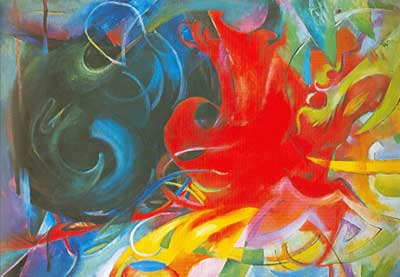
Marc’s radical, sophisticated simplification of the palette and attentive treatment of Russi’s individual characteristics – the dog wears a violet martingale marking him as a member of the Marc household – give a direct and appealing clarity to the image. The large size of the canvas (65 by 105 centimetres), and the dominance of Russi’s occupation of it, place the dog in the viewer’s phenomenological space – at human eye-level – and enfolds beholders into a sense of being protected and undisturbed. 2 The position of Russi’s body and the nest-like arrangement of the tree trunks and patches of earth in the surrounding space leave little doubt that the dog intends to linger in this state for some time.

Russi extends his left foreleg so that his chin rests upon and is supported by his paw, a position that, through iconographic tradition in German art, telegraphs a pensiveness that will resolve into renewed creative energy (Figure 2). The stillness of the dog’s body and the undisturbed, slowly melting snow indicate that the dog is in a state of calmness and relaxation. His body represents the unity inherent in the almost oval shape he occupies within the picture, echoing the mix of angles and contours from the wedge of his head to the rounded haunches under which his rear legs are folded. Russi closes his eyes in the satisfied contentment into which he has retreated. Snow that under the warmth of the dog’s body has begun to melt. Franz Marc, Liegender Hund im Schnee (1912). In thinned oil pigment on a large horizontal canvas, Franz Marc painted a portrait of a white dog, his own Siberian sheepdog Russi, in comfortable repose on a blanket ofįigure 1. This extended analysis provides the necessary background to assess more fully the nature of the leap in the thought behind making and viewing paintings of animals which Marc thought was necessary both to appreciate the new art and connect the idea of a lost paradise with a utopian future. I devote particular attention to Marc’s vocabulary and choice of titles and modes of representation for his portraits of his dog, Russi.Įxamined here are a representative sample of the type of painting that makes a case for this interpretation, Marc’s Liegender Hund im Schnee (Figure 1), to offer a detailed description of how this process of observation, appropriation, execution, and interpretation works. In proposing a combined interpretation of paintings, artists’ writings, and the contemporary art environs Marc worked in, I aim at understanding the process of looking at Marc’s art as a social practice construed though the interaction of artist, animals, and viewers in specific environments connecting images, words and, in Marc’s estimation, a sort of spiritual intuition.

Thus while referential content became less and less recognizable in the work of Marc’s close associate, Wassily Kandinsky, for Marc creating entirely gegenstandslos painting was never a goal – though not my primary area of inquiry, this is an important revision in what we normally think of as the agenda of the Blaue Reiter. Very much in the same way as historic and contemporary notions of Einfühlung imply a mode of spectatorship where both the body and the imagination have an important role, Marc’s aspiration to blend the painted canvas with the soul is grounded in an idea of perception where those souls are also embodied.


#Franz marc art style full#
1 The full understanding of this connection is central for illuminating the idea of Marc as a sort of naturalist who used the work of other painters as well as direct observation of animals and nature to challenge entrenched beliefs about spectatorship, pictorial space, and the consciousness of animals. They are intimately connected to his intention to »intensify the aesthetic emotions … by blending the painted canvas with the souls of the spectator and the animal«, a desire which led him to declare that the human viewer must be »placed in the center of the picture«. The rejection of the general state of society, particularly its expression in art, and the elevation of the Tierbild to spiritual relic were fundamental concerns for Franz Marc.


 0 kommentar(er)
0 kommentar(er)
